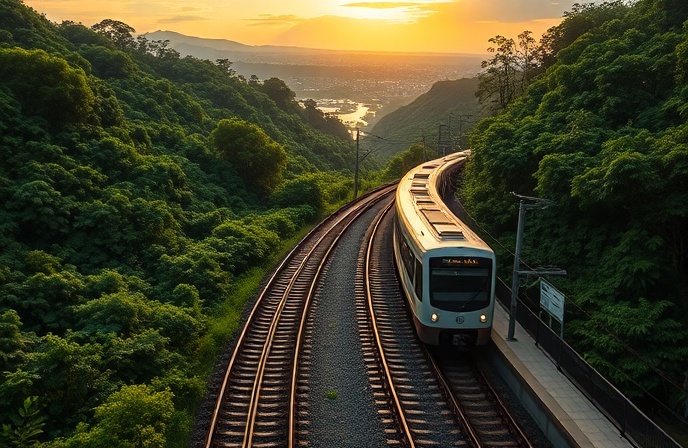Skoda & Tesmec: Green Rail Revolution

The global railway industry is undergoing a significant transformation, driven by the urgent need for sustainable and high-performance solutions. This article delves into a key partnership between Škoda Group, a prominent Czech rolling stock manufacturer, and Tesmec Rail, a leader in railway infrastructure technology. Their collaboration focuses on developing cutting-edge, environmentally friendly railway products for worldwide deployment. This strategic alliance represents a pivotal shift towards a greener future for rail transport, tackling challenges related to energy efficiency, reduced emissions, and enhanced operational reliability. The partnership leverages the combined expertise of both companies, integrating Škoda’s advanced traction equipment with Tesmec’s infrastructure solutions to deliver a comprehensive, sustainable offering. We will explore the technological advancements driving this partnership, its implications for the broader railway industry, and its alignment with global sustainability initiatives. The analysis will also consider the long-term implications of this collaboration and its potential to influence future developments in the rail sector.
A Strategic Partnership for Sustainable Rail
The collaboration between Škoda Group and Tesmec Rail is centered around the production of 44 electric gearbox-fitted trains, showcasing a commitment to sustainable mobility. This substantial order, to be delivered between 2024 and 2028, demonstrates the significant scale of their joint venture. These trains incorporate several key features highlighting advancements in railway technology, notably a revolutionary bimodal propulsion system. This system allows the trains to operate using either a 3kV DC or a 25kV AC overhead line power supply, crucial for interoperability across various European rail networks. Further enhancing interoperability, the trains are equipped with European Rail Traffic Management System (ERTMS)/European Train Control System (ETCS) Level 2 and STM SSC/SCMT BL3 onboard systems, ensuring seamless integration into existing infrastructure. This commitment to interoperability underscores the partnership’s aim to establish a global standard for advanced and sustainable railway solutions.
Technological Innovation and Environmental Responsibility
The partnership’s focus on sustainability is reflected in the incorporation of Škoda Electric’s advanced traction equipment. This equipment significantly contributes to improving the energy efficiency of the trains, leading to reduced energy consumption and lower greenhouse gas emissions. The trains’ design also incorporates considerations for improved passenger comfort and safety, adding a crucial element to the overall sustainability equation. A holistic approach, considering not only emissions but also passenger experience and operational reliability, is vital to the success of a truly sustainable rail system. The use of electric locomotives, alongside potential heat recycling HVAC (Heating, Ventilation, and Air Conditioning) systems, further underscores the commitment to environmental best practices.
Meeting the Challenges of Sustainable Development
The partnership directly addresses the challenges of maintaining sustainability within the railway industry, a sector facing increasing pressure to reduce its environmental footprint. Both Škoda and Tesmec actively promote Environmental, Social, and Governance (ESG) strategies, making sustainable innovation a central pillar of their business models. The collaboration exemplifies the increasing recognition that sustainable practices are not only environmentally responsible but also crucial for long-term business success. The partnership’s adherence to the highest technical standards and compliance with relevant regulations, including Technical Specifications for Interoperability (TSI), ensures that the produced solutions meet stringent safety and performance requirements, further reinforcing the commitment to quality and reliability.
Alignment with European Union Objectives
The Škoda-Tesmec collaboration aligns perfectly with the European Union’s vision for a sustainable, safe, and integrated European transport system. The European Union Agency for Railways (ERA) plays a critical role in setting standards and ensuring interoperability across national borders. This partnership directly supports the ERA’s objectives by promoting the development and deployment of sustainable technologies that seamlessly integrate into the broader European rail network. The emphasis on interoperability, through ERTMS/ETCS Level 2 and other standardized systems, underscores the commitment to creating a truly unified and efficient European railway system. This strategic alignment with EU policy ensures that the innovation fostered by this partnership contributes significantly to broader European goals for sustainable transportation.
Conclusion
The partnership between Škoda Group and Tesmec Rail marks a significant step towards a more sustainable and technologically advanced future for the global railway industry. The development and deployment of 44 electric, bimodal trains, featuring advanced traction equipment and comprehensive interoperability systems, represent a concrete demonstration of their commitment to environmental responsibility and innovation. The collaboration goes beyond simply delivering new rolling stock; it signifies a holistic approach to sustainable rail, encompassing energy efficiency, passenger comfort, safety, and alignment with broader European Union initiatives. The success of this partnership, which prioritizes both technological advancement and environmental stewardship, serves as a model for future collaborations within the rail sector. The adoption of ESG principles as core business strategies by both Škoda and Tesmec highlights the growing recognition that sustainable practices are not only ethically sound but also economically viable, paving the way for a greener and more efficient railway network worldwide. The emphasis on interoperability, particularly through the integration of ERTMS/ETCS, ensures that the benefits of this collaboration extend beyond national borders, contributing to the creation of a truly seamless and sustainable European rail system. This strategic alliance points towards a future where sustainable practices are not simply an add-on but an integral part of the design and operation of railway systems, ultimately shaping a more environmentally responsible and efficient transportation landscape.




